In a YouTube video titled, “Ben Shapiro DESTROYS Transgenderism and Pro-Abortion Arguments,” Shapiro made several claims about suicide. His video currently has 3,126,889 views, which is probably 3,126,885 more views than this blog post will get. Because I feel strongly about making accurate mental health information available to the public, I decided to put a good faith effort into fact-checking the video despite my limited reach. I focused on the suicide-related claims in the video, because I am cautious about commenting on topics outside of my areas of expertise. His statements appear below in bold and my evaluations of their veracity, using empirical data, are beneath them.
1. “The idea behind the transgender movement, as a civil rights movement, is the idea that all of their problems would go away if I would pretend that they were the sex to which they claim membership. That’s nonsense. The transgender suicide rate is 40%. It is 40%.”
False. The American Foundation for Suicide Prevention-Williams Institute study that he appeared to be referencing found that 41% of a sample of transgender and gender-nonconforming (TGNC) adults reported having a lifetime suicide attempt, not a suicide death. The distinction between suicide attempts and suicide deaths is important for reasons directly noted in page 4 of the report:
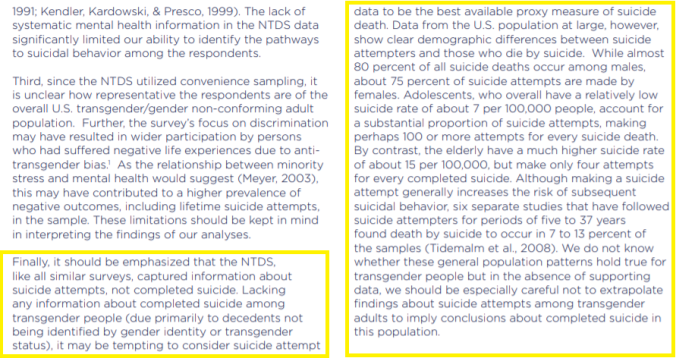
It’s possible Shapiro misspoke here and genuinely could not recall the information accurately, but I have not seen a correction released from The Daily Wire despite the highly-viewed video being out for over a year. If you see that a correction has been made, please let me know, and I will update this post.
2. “According to the Anderson School of UCLA, it makes no difference – there’s a study that came out last year – it makes no difference, virtually no difference statistically speaking, as to whether people recognize you as a transgender person or not, which suggests there’s a very high comorbidity between transgenderism — whatever that mental state may be — and suicidality that has nothing to do with how society treats you.”
False. As mentioned above, I believe that Shapiro meant the Williams Institute of UCLA study instead of the “Anderson School of UCLA,” and that was simply a mistake. But Shapiro gets two things wrong here. First, I am not certain, but based on the context from the full video, I think he misconstrued or misused how “recognition” was defined in the study. The study measured whether people tend to recognize (in the sense that they can tell) that a person is TGNC rather than recognition in the sense I think Shapiro meant (accepting a transgender person’s gender identity as valid — e.g., personally and/or legally). Secondly, there was a statistically significant difference found in the study’s recognition analysis, as seen in pages 8 and 9 of the report:
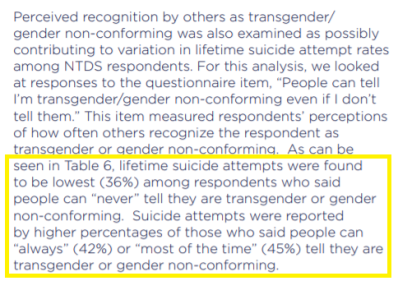

Regarding the next part of his claim, how society treats you does appear to be correlated with suicidal ideation and suicide attempts among TGNC individuals, including in the study he referenced (from the Executive Summary, more details on pp. 11-13):
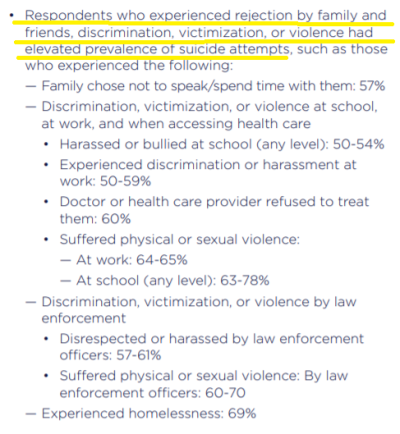
In a separate study, TGNC youth reported whether or not people called them by their preferred name in 4 domains (home, school, work, friends). They found that chosen name use in more contexts (which the researchers used as a proxy of gender affirmation — i.e., recognizing the validity of their gender identity) was correlated with lower depression symptom levels, less suicidal ideation, and less suicidal behavior. This study was published after his video was made, but I am adding it here for informational purposes.
3. “The idea that the normal suicide rate across the United States is 4% — the suicide rate in the transgender community is 40% — the idea that 36% more transgender people are committing suicide because people are mean to them is ridiculous. It’s not true, and it’s not backed by any science that anyone can cite. It is pure conjecture. In fact, it’s not even true that bullying causes suicide…according to a lot of studies.”
False/Oversimplified. His larger point of comparing TGNC suicide attempt rates to general population rates is informative for characterizing disparities, but the 4% statistic reflects the lifetime suicide attempt rate featured in the report rather than the suicide death rate. Regardless, I don’t think that people typically claim that the entire explanation for the TGNC/general population suicide attempt rate disparity is due to meanness/bullying. Rather, the argument is that certain stressful factors (including some typically considered mean/bullying) may contribute to a higher risk for suicide attempts among transgender people. For example, from page 13 of the report:
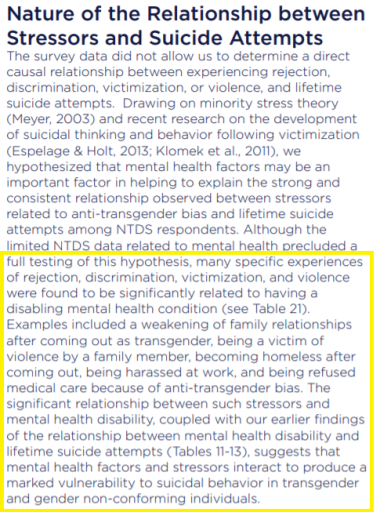
Suicidologists do not talk about suicide as being caused by one factor, because there are a multitude of interacting factors at work. That is why I consider the bullying claim to be oversimplified. Moreover, there is scientific evidence that being bullied is associated with higher levels of suicidal ideation and suicide attempts (e.g., 1, 2,3) and that bias-based harassment (e.g., due to sexual orientation or race) is associated with particularly negative effects.
4. “For example, in the Black community where the idea is supposedly that America’s a racist society….Blacks are bullied a lot. Okay, in the Black community, there’s significantly lower suicide rates than in the White community.”
Half True. It is true that, in the United States, Black people generally have lower suicide rates than White people (over most age ranges, with the exception of the higher suicide rates found among Black children than White children) as you can see from this table of CDC data posted on the American Association of Suicidology website (where rate is defined as number of suicides by group/by the population of the group X 100,000):

But this does not, as Shapiro suggested, prove that bullying is unrelated to suicide rates. As mentioned above, suicide is an outcome influenced by the interplay of risk and resilience factors. If, hypothetically, one group was bullied in equal amounts as another group, and there were disparate suicide rates, that does not necessarily mean that the group with the higher rate has a particular mental state with comorbidities (as Shapiro characterized being transgender) that accounts for all of the difference. It could be due to a number of possible factors (e.g., being a member of a group that, on average, has less social support to buffer against risk factors like bullying).
Further, racism is evident in various domains (e.g., discrimination in housing, education, healthcare, voting, and the criminal justice system), but bullying may not be one of them. At least one study using a nationally representative sample found that Black youth (19%) reported being bullied at comparable rates to White youth (21%).
5. “In fact, in third world countries, the suicide rate is significantly lower than in first world countries. Suicide actually seems to be a privilege of the upper classes if you actually look at it from a financial perspective. So, the idea that suicidality is directly a result of people like me saying, ‘No, men are not women and women are not men.’ It’s not true.”
Mostly false. I’m not sure that I fully understand the thread through this argument. My best guess, based on the full video context, is that Shapiro proposed that suicide occurs more among people with societal privilege and therefore high suicide attempt rates among transgender people would not be improved if they had more societal privilege? Or that denying the validity of transgender people’s gender identity and bullying do not increase risk for suicide, but having a lot of money does?
There are two claims to fact-check here. First, I’ll focus on the statement about suicide rates in “third world” (developing) vs. “first world” (developed) countries. To evaluate this, I examined the World Health Organization‘s 2016 suicide data by country (units are # of suicide deaths/100,000 people) paired with the World Bank’s 2017 country classification data (high income, upper middle income, lower middle income, low income). There was a lot of variability within the categories (especially in the high income group). For example, the high income group (n = 50) ranged from 0.5/100,000 (Antigua and Barbuda) to 31.90/100,000 (Lithuania). Meanwhile, the low income group (n = 31) ranged from 3.7/100,000 (Malawi) to 11.7/100,000 (Haiti). I conducted an ANOVA on the 174 countries I had data for and found statistically significant differences in the direction that Shapiro asserted. Stats people may have noticed that the assumption of homogeneity of variance was violated and that the groups are unequal sizes. Parallel analyses using a robust (Welch’s) ANOVA and nonparametric (Kruskal-Wallis) testing suggested comparable results.
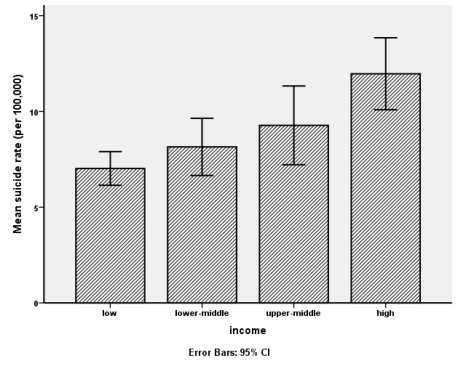
Because Shapiro mostly meant suicide attempts when talking about suicide deaths, I’ll also include results from a study which found, “twelve-month prevalence estimates of suicide ideation, plans, and attempts were 2.0%, 0.6% and 0.3% respectively for developed countries and 2.1%, 0.7% and 0.4% for developing countries.” There were no meaningful differences for suicide attempt rates related to developed/developing status in that study, and contrary to Shapiro’s second claim, they found that lower income was associated with higher levels of suicidal ideation, plans, and attempts in both developing and developed countries. Similarly, a meta-analysis revealed that low (not high) income level was associated with increased risk for death by suicide:


In summary, at a broad level (developing vs. developed countries), Shapiro accurately described the pattern of suicide rates. However, when examining the variables with more precision (e.g., at the individual financial status and suicide risk level), the data are inconsistent with his claim that suicide is a “privilege of the upper class.” It is possible that specific societal structures and cultural elements better account for the observed disparities in national suicide rates.
In conclusion, Ben Shapiro argued that he and others should not be pressured into personally or legally recognizing transgender people’s gender identity as valid rather than their assigned sex at birth. One way that he tried to justify those feelings was to make several statements purportedly proving that societal treatment of transgender people has no impact on their suicide risk. Shapiro has every right to have and express his feelings on this issue. However, his feelings don’t change the fact that societal treatment is, according to a lot of studies, related to suicide risk among transgender people.
—-
Note 1: The widely-watched Shapiro video is from February 19, 2017, and as of May 14, 2018, I see no notation that corrects any of the misinformation in the video or on his website. If you are aware of such corrections, please contact me, and I’ll update the post.
—–
Note 2: For more information and resources about suicidal behavior among TGNC people, please see my post about gender dysphoria and suicidality in Laura Jane Grace’s memoir and the links below:
For Accurate Information on this Topic: American Psychological Association
Learn More about the Lived Experiences of TGNC People in Their Own Words: Aydian Dowling, Chaz Bono, ContraPoints, Janet Mock, Jazz Jennings, Laverne Cox, Leelah Alcorn, Live Through This Project, Trans documentary, True Trans documentary series with Laura Jane Grace
Suicide Prevention Resources: American Association of Suicidology, American Foundation for Suicide Prevention, Darcy Jeda Corbitt Foundation, National Suicide Prevention Lifeline, Trans Lifeline, The Trevor Project
Information for Mental Health Professionals about Affirming Psychological Practice With TGNC People: APA Guidelines, A Model for Children & Adolescents
—–
Thank you to Linda & Keith for helping me figure out how to best fact-check #5.
3,126,884 views more. I more view for you, one less for Shapiro!
LikeLiked by 1 person
Every proselisor should have a fact check running side by side with their claims made in videos made for unilaterist audiences.
LikeLike
Someone FINALLY fact checking Shapiro. Thank you!
LikeLiked by 1 person
You’re welcome! Thanks for reading!
LikeLike
Pingback: How Psychologists Capture the Complexities of Mental Illness | Kathryn H. Gordon, Ph.D.
Pingback: Ben Shapiro Shows Us How To Be A Hack | real_amerikareader
Pingback: Can Offensive Political Speech Cause Trauma? | Kathryn H. Gordon, Ph.D.
Pingback: Science Can Meaningfully Advance Public Discussion About Suicide | Kathryn H. Gordon, Ph.D.
Sorry, but I don’t get the wrong part about the “upper class” thing. In the graph you presented, you can see that the suicide rate and income are correlated, hence the more income you have, the higher is the suicide rate. Later you say that actually low-income people think about commiting suicide more often, because before he referred to the suicide attempt rate of transgender people as “suicide rate”, so I get it, but that doesn’t mean he is wrong in the second statement, if we forget about the first one. Am I missing something here, right?
LikeLike
It’s kind of confusing, but the way it breaks down is that higher income countries tend to have higher national suicide rates altogether. Within each country, the people with lower income are more likely to be the ones dying by suicide (that’s what the table shows).
LikeLike
Pingback: Suicide Prevention for Trans & Gender Diverse Adults with Dr. Raymond Tucker | Psychodrama